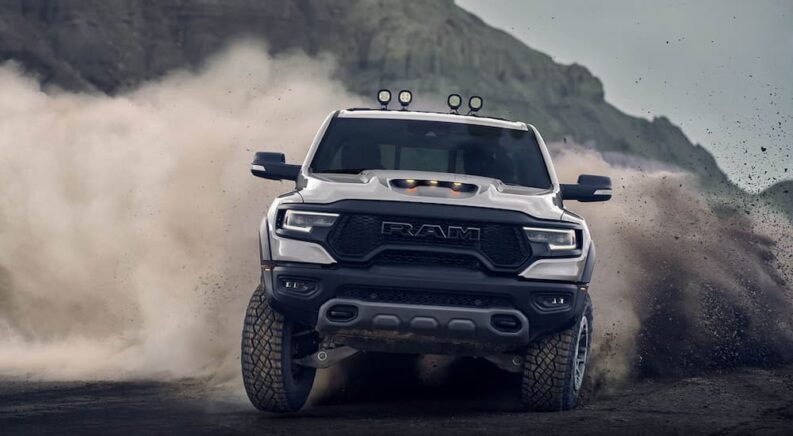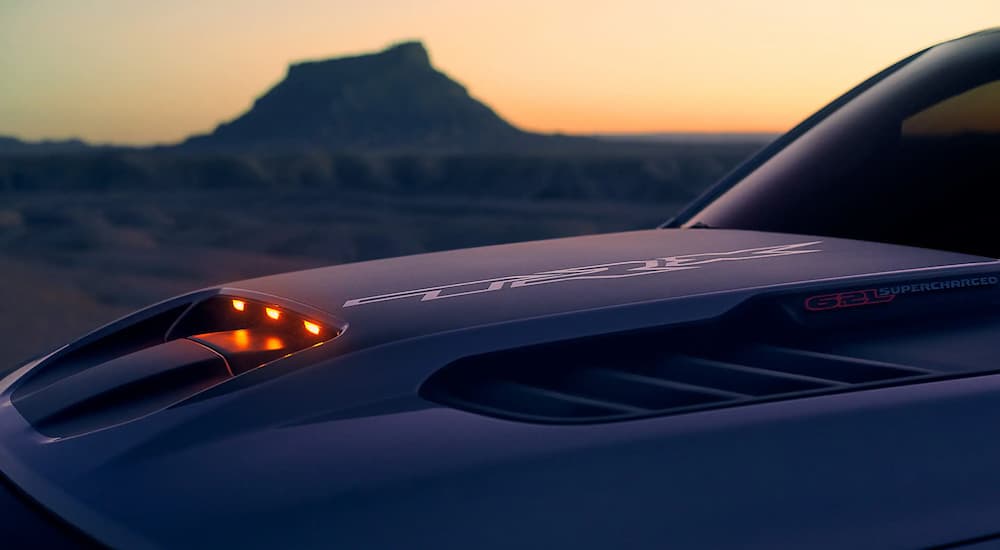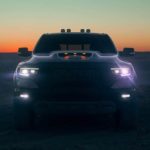There’s never a question of whether we need more power in our trucks because the answer is obvious: always, and undoubtedly, “yes.” Ram gets this, proving as much with models like the Ram TRX, a truck that’s transformed dealership lots across the country as one of the most coveted Ram trucks for sale. As the fastest street-legal production truck in its class, the Ram TRX has ignited fierce competition in the industry and inspired the likes of rivals like the Ford Raptor R.
These supercharged beasts are comparable, delivering jaw-dropping horsepower and mind-blowing torque that ensure the thrill of a lifetime in the driver’s seat. But what led Ram and Ford to rely on superchargers rather than turbocharged engines to deliver this level of power? The 2023 Raptor (not to be confused with the Raptor R) with its 450 hp, twin-turbocharged 3.5L EcoBoost gives us a hint, but it does little—at least by numbers—to explain what the real difference is between supercharged and turbocharged speed demons. After all, 450 hp is still impressive, but it’s not enough to earn Jurassic-like status.
The Endless Struggle for Power
While every generation likes to think they’ve cornered the market on the need for speed, pushing the envelope is the very thing that’s defined the transportation industry over the last century. We’ve capitalized on the ingenuity of decades past, undeniably going faster than automotive pioneers ever anticipated. Even so, we can’t disregard the constant pursuit of speed and its impact on the current automotive landscape and iconic speed demons like the Ram TRX.
In the early 1900s, a century before the Ram TRX, aircraft pilots faced a unique problem: planes suffered significant losses in power when flying at higher altitudes. What was the issue? Well, because air is thinner at higher altitudes, airplane engines have fewer oxygen molecules available for combustion. Less oxygen means less power. Therefore, engineers had to find a way to force induction, and they did so with the development of the turbosupercharger. The first iteration of the turbo allowed planes to operate as they would at lower altitudes, tricking the engine into thinking the air was denser.
Although initially designed to compensate for altitude, the turbosupercharger eventually found a place in the automotive industry as a “replacement for displacement,” as Motor Trend puts it. Throughout early automotive history, we see the constant development of new engines with bigger displacements. However, there’s a remarkable shift in these innovations as environmental concerns take precedence and government standards regulate engine emissions. This combination has forced automakers to pivot, giving superchargers and turbochargers room to shine. And to think, neither would be possible without aircraft pilots struggling to maintain power as they flew across the country in the 1910s.
Supercharged or Turbocharged: Same Idea, Different Delivery
While aircraft implemented the turbosupercharger to trick the engine into thinking it was flying lower than it was, this same principle applies to modern trucks like the Ram TRX, Ford Raptor R, and every other speed demon with a supercharger or turbo under its hood. In this regard, superchargers and turbos have the same goal—to deliver more power without needing a bigger engine—and it accomplishes this the same way: by making the air denser, pushing more air toward the engine to generate more power. How the supercharger and turbo both perform this feat, however, is vastly different.
Turbocharged Power
A turbocharger takes what’s already there—the exhaust generated from the combustion process—and uses it to create more power. Every turbocharger features two critical components: a compressor and a turbine. The latter relies on its housing to capture exhaust gas and push it toward the turbine wheel. As the exhaust gas turns the wheel, it exits the housing through the exhaust outlet. Alternatively, the compressor does the exact opposite. The turbine is attached to the compressor wheel, turning it as the spinning wheel brings in air and compresses it; then, the compressed air moves into the housing, where it’s diffused or converted into a high-pressure, low-velocity air stream. From there, the air is forcibly pushed into the engine.
Supercharged Power
While turbos rely on the exhaust to generate more power, superchargers use the engine and draw their power from the crankshaft using a belt, chain, or gear. Essentially an air compressor, a supercharger must spin faster than the engine to pressurize the incoming air. To ensure this happens, most drive gears are larger than the compressor, generating higher revolutions per minute, or RPMs. At the same time, the supercharger relies on an intercooler to keep the compressed air at the optimal temperature. The intercooler works like a radiator, reducing the temperature of the air and increasing its density to optimize combustion. As a result, superchargers can boost an engine’s horsepower by 46%, on average, and increase torque by 31%.
The Pros and Cons of More Power
Is there ever a downside to more power? While there are no real disadvantages to increasing power output, superchargers and turbos offer distinct advantages. Although it’s a give-and-take with each option, enthusiasts tend to fall on one side or the other. How so?
Turbochargers are more readily available in the current industry because they’re designed to optimize the performance of smaller engines without compromising efficiency. For example, we see turbocharged EcoBoost engines from Ford in trucks like the 2023 Raptor, which produces 450 hp and 510 lb-ft of torque. This is an incredible output for a full-size truck, especially considering the turbo is only using what’s already there—the exhaust. However, there’s a downside to this when it comes to off-the-line acceleration. A turbocharger takes a minute to respond, which is known as turbo lag. While turbo lag is nothing of concern in your everyday drive, it’s a significant factor when you’re on the racetrack or looking for a thrill behind the wheel.
Because of this, superchargers are the go-to for high-performance models like the Ram TRX. The supercharger’s direct connection to the engine via the crankshaft means it works simultaneously, ensuring immediate responsiveness. In other words, there’s no lag when you hit the accelerator pedal. This gives trucks like the Ram TRX an incredible advantage when accelerating off the line because the burst of power is a knee-jerk response.
Likewise, a supercharger isn’t designed for efficiency. While a turbocharger won’t improve fuel economy, it doesn’t make a dramatic impact because it relies on energy that would have otherwise been discarded in the exhaust. Alternatively, the supercharger is solely focused on performance, and—with trucks like the Ram TRX—fuel efficiency is far from your mind when you’re pushing the Jurassic-inspired predator to its limits.
The Constant Pursuit of Power
Turbos and superchargers are evidence of our constant pursuit and demand for more power. We replaced the trusty steed with the automobile because it made getting from Point A to Point B easier, more convenient, and far more comfortable. Today, we’re capitalizing on a century of innovations with modern marvels like the supercharged Ram TRX.
Even turbo-powered cars and SUVs showcase our penchant for speed and our ongoing efforts to push the envelope and travel faster without compromise. Ironically, the turbocharger was nothing more than a means to trick airplane engines into thinking they were flying at lower altitudes. Today, turbos and superchargers trick engines into thinking they’re bigger than they are, allowing us the beauty of traveling fast without widening our carbon footprints. It’s an intricate and remarkable balance that’s led to over 700 hp of pure thrills behind the wheel.






